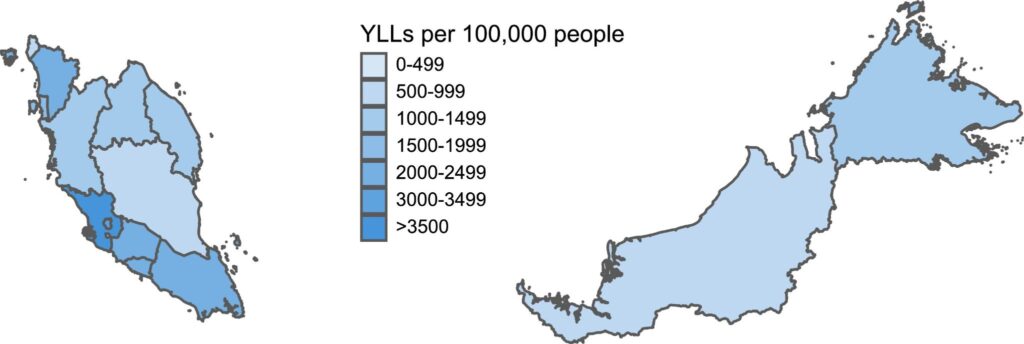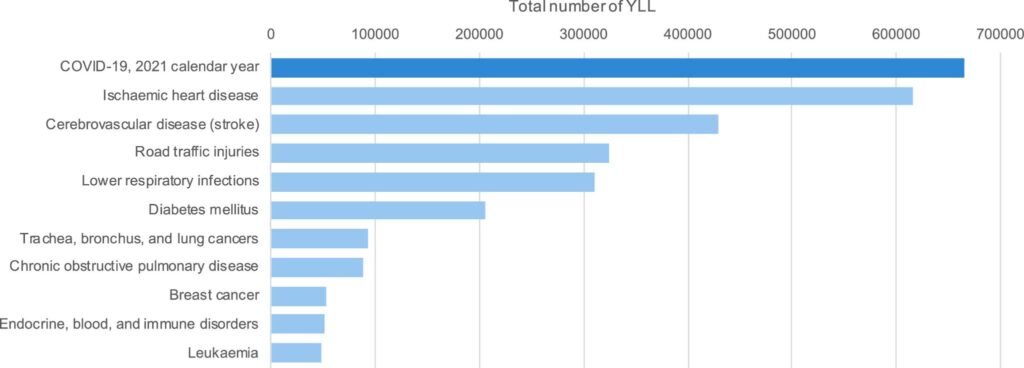KUALA LUMPUR, June 10 – More than 683,000 extra years of human life were lost due to Covid-19 in Malaysia over the past two years of the pandemic, according to a recent study conducted by researchers at the Ministry of Health (MOH).
The study, published in The Lancet on April 26, considered years of life lost (YLL) – a metric that measures the degree of premature mortality among the dead by comparing the ages of the deceased to their life expectancies – using publicly available data from the MOH and the Department of Statistics Malaysia (DOSM).
The authors of the study, led by a researcher from MOH’s Institute for Public Health (IPH), said the YLL measure owing to premature death from a disease, offers “a more appropriate metric” than death counts for measuring the mortality burden of a disease on the population as it recognises deaths at young ages.
The researchers used the national life table for the year 2017 as a benchmark for their study.
The study also compared YLL rates across different states and weighed up the impact of mortality directly attributable to Covid-19 relative to deaths from other leading causes of disease and injury in the country in pre-pandemic times.
“We estimated that Covid-19 accounted for 683,903 YLL over the past two years – approximately 21 years lost per person who died of Covid-19, and 1,998 years per 100,000 people,” the authors wrote.

The highest fall in life expectancy per capita occurred in Selangor, with 3,473 extra years lost per 100,000 people, with the Federal Territory of Labuan coming in a close second at 3,457 years per 100,000 people.
Men saw a bigger drop in life expectancy per 100,000 people at 2,132 years versus women at 1,853 years over two full years of the pandemic in Malaysia from February 5, 2020, where a total of 32,063 Covid-19 deaths were recorded as of February 5, 2022.
Most Covid deaths (31,059 out of 32,063 deaths) occurred in 2021, and the highest number of deaths occurred in the 60-64 years age group (13 per cent) in men and in the 80 years and above age group (18 per cent) in women.
By age group, YLL was highest in the 55−59 years age group in men, and in the 45-49 years age group in women.

The authors also noted that the mortality burden directly attributable to Covid-19 over the 2021 calendar year (665,029 YLL) exceeded that caused by ischaemic heart disease, which was the leading cause of fatal burden in the country in pre-pandemic times.
Covid-19 also accounted for more than two times the amount of YLL associated with lower respiratory tract infections in 2017.
The life expectancy lost from Covid-19 in 2021 was also higher compared to road traffic injuries, diabetes, lung cancer, chronic obstructive pulmonary disease (breathing-related problems), metabolic disorders, breast cancer, and leukaemia recorded in 2017.

“These YLL estimates highlight that the Covid-19 pandemic has caused a considerable mortality impact on the Malaysian population.
“While we recognise that these preliminary estimates do not even begin to quantify the magnitude of losses experienced by other wider ranging effects of the pandemic beyond loss of life, we hope that reporting the comparative population health impact of Covid-19 lends perspective to the debate on whether the implementation of radical mitigation measures including multiple movement control orders (i.e. lockdowns) were necessary,” the authors wrote.
Future work is underway to quantify the morbidity burden and other effects of Covid-19, including long Covid – a collective term denoting prolonged and persistent symptoms in those who have recovered from SARS-CoV-2 infection – which, the authors noted, will require further understanding in order to assign appropriate disability weights for the calculation of years lived with disability (YLD).
They added that continued estimation of the disease burden associated with Covid-19 at regular intervals will be helpful in quantifying potential losses averted by the rollout of the National Covid-19 Immunisation Programme (PICK).








